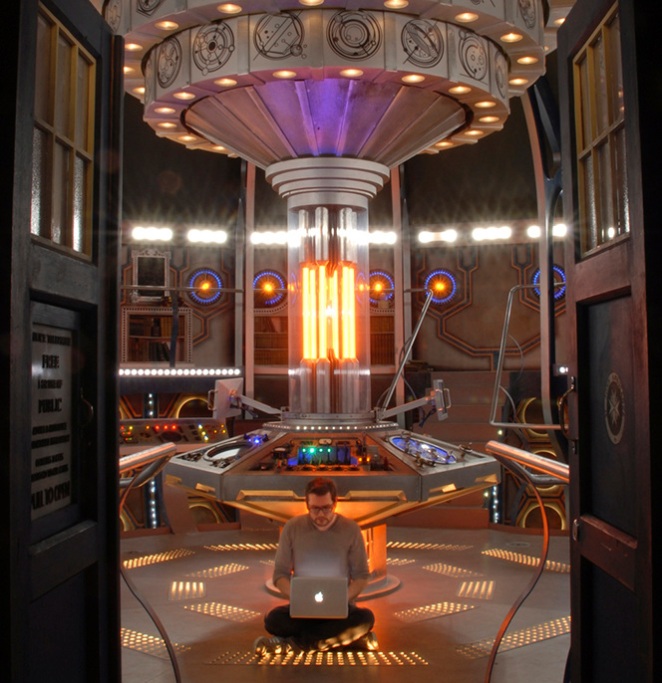Matthew Clark has worked as a Graphic Designer for a number of years across a range of genres from cop shows to science-fiction. His recent credits include Red Dwarf, Black Mirror and A Midsummer’s Night Dream. Matthew also worked on the entirety of Series 9 of Doctor Who and five episodes from Series 10. But what does a Graphic Designer actually do?

WHO SFX: Can you tell me a bit more about your role as graphic designer on Doctor Who and what your key responsibilities are?
Matthew: Graphic Design for TV shows has changed tremendously in the last 10 years or so – once where it would have been a lot of hand-drawing, using Letraset etc. it now covers almost anything on screen that isn’t a purchased prop. I do anything that would be printed – posters, tickets, newspapers, signs, etc., but also the majority of video screens, mobile devices, anything like alien control panels, and thanks to newer technology like laser cutting and large format printing, I can be doing constructed, 3D graphics as well as printing whole floors/carpets/walls! Any photo-shoots that an episode might need tend to fall under the Graphic Designer’s role.
Who SFX: How did you get started in this line of work?
Matthew: I studied film-making at the University of Derby – it was a practical course where you’d be given a few hundred feet of 16mm film at the start of each term and you had to hand in a finished project at the end of it. I was always fascinated by props and models as a kid, as well as set design, so my films tended to be based around built sets or miniature models. From that, I started getting asked to make bits for other people, and my first few industry jobs were as a prop maker. However, I was definitely better at it as a hobby than a profession so I moved across into 3D modelling for the Art Department, which bled into doing Graphic work, which became my real interest.
Who SFX: At what stage of the production process doyou first get involved?
Matthew: I get involved at the same time as the rest of the Art Department – which is fairly early, usually as soon as a complete, working draft of the script is ready to go. From there we all prep by doing research for the era/setting of the episode, creating some rough designs to send onto the Director/Producers, working out what things will cost, lead times etc. As the script evolves, so do the graphics – sometimes the night before shooting! We then tend to run alongside the first 2 weeks of the shoot – hopefully everything will be done by then – before prepping for the next episode.
Who SFX: What makes Doctor Who more challenging than other productions you’ve worked on?
Matthew: The series is more challenging just by the nature of the Doctor Who’s setting – unlike a lot of shows each episode can be wildly different, and a good amount of the episodes are future/space based which means more complicated graphics work. The average spaceship will need several motion graphic screens, Perspex printed control panels, vinyl decals, foil decals etc. There’s a lot to create! Keeping each episode’s look fresh is also a challenge – you always have to try to find a way of creating something different to the last time you made a similar thing. We’re often forced to re-use props and set pieces, so it can come down to the graphics to make it look different. In Series 9 the same control desk appears two or three times with completely new graphics in it each time! Doctor Who also has a lower budget than a lot of less visually intensive shows, not to mention a shorter production time, so on top of trying to create a new look you have to be able to do it both quickly AND cheaply.
Who SFX: What have been the highlights of working on Series 10 of Doctor Who?
Matthew: The highlight of Series 10 for me was Episode 3, Thin Ice, for reasons that will become apparent when you see it! The sets were a HUGE undertaking and even though they weren’t graphic intensive, it was the most ambitious thing we’d done in my time there and it looked stunning. Our production designer, draughts people, construction crew, set dressers and standbys should all be proud of what they achieved.
Who SFX: What advice would you give to people starting out in the industry?
Matthew: If someone is looking to get into the industry, then the key thing I would suggest is that they work out what they want to do, and specialise. If you want to be in the Art Department, work out if you want to do graphics, or 3D modelling, draughting etc. If you have a niche you can focus on then you can find your way in to the industry much more quickly. If you’re starting out and don’t have much work to show, make a spec folio, demonstrate what you’re capable of. Many more Art Directors have online folios and contact forms than they used to, so with a bit of time with IMDB and Google you can find people to introduce yourself to. It’s a bit like cold calling, and you don’t always get replies, but it’s worked for a lot of people!
Thank you Matthew.

You can find out more about Matthew’s stunning work on his website:
